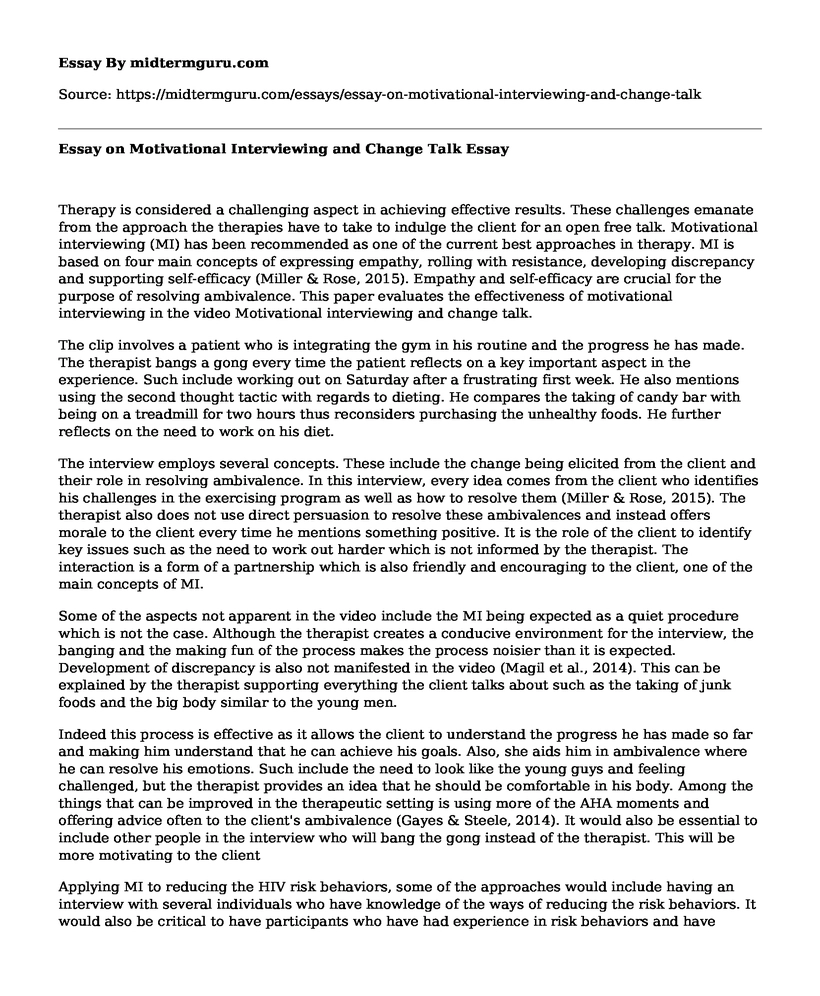Therapy is considered a challenging aspect in achieving effective results. These challenges emanate from the approach the therapies have to take to indulge the client for an open free talk. Motivational interviewing (MI) has been recommended as one of the current best approaches in therapy. MI is based on four main concepts of expressing empathy, rolling with resistance, developing discrepancy and supporting self-efficacy (Miller & Rose, 2015). Empathy and self-efficacy are crucial for the purpose of resolving ambivalence. This paper evaluates the effectiveness of motivational interviewing in the video Motivational interviewing and change talk.
The clip involves a patient who is integrating the gym in his routine and the progress he has made. The therapist bangs a gong every time the patient reflects on a key important aspect in the experience. Such include working out on Saturday after a frustrating first week. He also mentions using the second thought tactic with regards to dieting. He compares the taking of candy bar with being on a treadmill for two hours thus reconsiders purchasing the unhealthy foods. He further reflects on the need to work on his diet.
The interview employs several concepts. These include the change being elicited from the client and their role in resolving ambivalence. In this interview, every idea comes from the client who identifies his challenges in the exercising program as well as how to resolve them (Miller & Rose, 2015). The therapist also does not use direct persuasion to resolve these ambivalences and instead offers morale to the client every time he mentions something positive. It is the role of the client to identify key issues such as the need to work out harder which is not informed by the therapist. The interaction is a form of a partnership which is also friendly and encouraging to the client, one of the main concepts of MI.
Some of the aspects not apparent in the video include the MI being expected as a quiet procedure which is not the case. Although the therapist creates a conducive environment for the interview, the banging and the making fun of the process makes the process noisier than it is expected. Development of discrepancy is also not manifested in the video (Magil et al., 2014). This can be explained by the therapist supporting everything the client talks about such as the taking of junk foods and the big body similar to the young men.
Indeed this process is effective as it allows the client to understand the progress he has made so far and making him understand that he can achieve his goals. Also, she aids him in ambivalence where he can resolve his emotions. Such include the need to look like the young guys and feeling challenged, but the therapist provides an idea that he should be comfortable in his body. Among the things that can be improved in the therapeutic setting is using more of the AHA moments and offering advice often to the client's ambivalence (Gayes & Steele, 2014). It would also be essential to include other people in the interview who will bang the gong instead of the therapist. This will be more motivating to the client
Applying MI to reducing the HIV risk behaviors, some of the approaches would include having an interview with several individuals who have knowledge of the ways of reducing the risk behaviors. It would also be critical to have participants who have had experience in risk behaviors and have managed to cope with it. While asking the questions such as examples of the HIV risk behaviors, it will be motivational to ensure every participant provides an example and an encouraging activity such as that of banging the gong. Through interviewing those who had experience with the activities, it would be essential to apply the main concepts of MI including expressing empathy and supporting self-efficacy.
References
Gayes, L. A., & Steele, R. G. (2014). A meta-analysis of motivational interviewing interventions for pediatric health behavior change.
Magill, M., Gaume, J., Apodaca, T. R., Walthers, J., Mastroleo, N. R., Borsari, B., & Longabaugh, R. (2014). The technical hypothesis of motivational interviewing: A meta-analysis of MIs key causal model.
Miller, W. R., & Rose, G. S. (2015). Motivational interviewing and decisional balance: contrasting responses to client ambivalence. Behavioral and cognitive psychotherapy, 43(02), 129-141.
Motivational Interviewing: https://www.youtube.com/watch?v=-ZmhD2kjNuY
Cite this page
Essay on Motivational Interviewing and Change Talk. (2021, Jun 10). Retrieved from https://midtermguru.com/essays/essay-on-motivational-interviewing-and-change-talk
If you are the original author of this essay and no longer wish to have it published on the midtermguru.com website, please click below to request its removal:
- Essay on Organizational Conflict and Conflict Management: Diversity and Conflict
- Annotated Bibliography on Treatment of Post-Traumatic Stress Disorder - Paper Example
- Annotated Bibliography on Obsessive Compulsive Personality Disorder - Psychology Paper Example
- Paper Example About Meaningful Executive Summary
- Article Analysis Essay: Walking on Sunshine
- Behavioral Psychology: Case Studies
- Rescue of Trapped Boys in Thailand: International Teamwork at Its Best - Essay Sample







